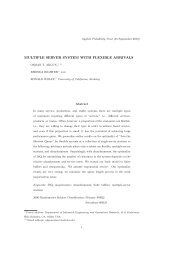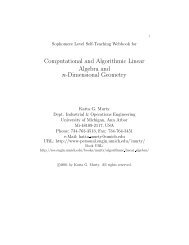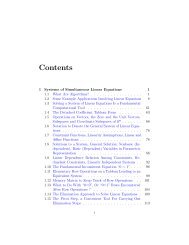Chapter 1 LINEAR COMPLEMENTARITY PROBLEM, ITS ...
Chapter 1 LINEAR COMPLEMENTARITY PROBLEM, ITS ...
Chapter 1 LINEAR COMPLEMENTARITY PROBLEM, ITS ...
You also want an ePaper? Increase the reach of your titles
YUMPU automatically turns print PDFs into web optimized ePapers that Google loves.
46 <strong>Chapter</strong> 1. Linear Complementarity Problem, Its Geometry, and Applications<br />
1.8 Write down the LCP corresponding to<br />
1.9 Let<br />
M =<br />
Minimize cx + 1<br />
2 xT Dx<br />
Subject to x > = 0 :<br />
8<br />
>:<br />
9<br />
8<br />
9<br />
;2 1><br />
q = >:<br />
1 ;2<br />
1><br />
:<br />
1<br />
Show that the LCP (q M) has four distinct solutions. For n = 3, construct a square<br />
matrix M of order 3 and a q 2 R 3 such that (q M) has eight distinct solutions.<br />
Hint. Try ; M =<br />
1.10 Let<br />
8<br />
>:<br />
2 ;1 ;1<br />
;1 3 ;1<br />
;1 ;1 4<br />
M =<br />
8<br />
>:<br />
9<br />
><br />
0 0 1<br />
0 0 1<br />
0 0 0<br />
9<br />
><br />
q =<br />
8<br />
>:<br />
q =<br />
1<br />
1<br />
1<br />
8<br />
>:<br />
9<br />
> or try M = ;Iq > 0 :<br />
9<br />
0<br />
;1><br />
0<br />
:<br />
Find out a solution of the LCP (q M) by inspection. However, prove that there exists<br />
no complementary feasible basis for this problem.<br />
(L. Watson)<br />
1.11 Test whether the following matrices are PD, PSD, or not PSD by using the<br />
algorithms described in Section 1.3.1<br />
8<br />
>:<br />
9<br />
0 1 ;1<br />
0 0 ;2><br />
1 2 1<br />
<br />
8<br />
>:<br />
9<br />
4 3 ;7<br />
0 0 ;2><br />
0 0 6<br />
<br />
8<br />
>:<br />
9<br />
4 100 2<br />
0 2 10><br />
0 0 1<br />
<br />
8<br />
>:<br />
9<br />
5 ;2 ;2<br />
0 5 ;2><br />
0 0 5<br />
:<br />
1.12 Let Q(x) =(1=2)x T Dx ; cx. If D is PD, prove that Q(x) is bounded below.<br />
1.13 Let K be a nonempty closed convex polytope in R n . Let f(x) be a real valued<br />
function de ned on R n . If f(x) is a concave function, prove that there exists an<br />
extreme point of K which minimizes f(x) on K.<br />
1.14 Let D be an arbitrary square matrix of order n. Prove that, for every positive<br />
and su ciently large , the function Q (x) =x T (D ; I)x + cx is a concave function<br />
on R n .










